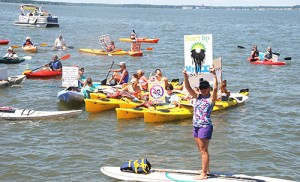
OCEAN CITY — Against the backdrop of a picture-perfect summer day in Ocean City, roughly 100 clean water activists participated in a “Float for the Coast” water rally against proposed offshore drilling for oil and natural gas off the mid-Atlantic coast.
Activists on kayaks and other vessels converged behind the Roland E. Powell Convention Center for the “Float for the Coast,” an on-the-water rally in support of clean water initiatives in general and against offshore oil and natural gas drilling and the associated seismic air gun testing specifically. The site was chosen because the convention center was hosting the annual summer meeting of the Maryland Association of Counties (MaCO) and state leaders on whose ears the message was directed.
Boats and kayaks of all shapes and sizes gathered in the coastal bays bearing signs with various messages. On different occasions, the chant “Don’t BP my OC” broke out as opponents extolled their message and listened to speeches from experts and clean water advocates.
Hosted by the Assateague Coastal Trust, in partnership with the Waterkeeper Alliance, Oceana, Waterkeepers Chesapeake and the Blue Frontier Campaign, the “Float for the Coast” was part celebration to embrace the water quality protections that allow thousands of locals and visitors alike to recreate safely in the coastal bays. It was also part demonstration to educate and raise awareness about the ongoing and looming threats to the fragile waterways, including offshore drilling and seismic testing.
“Our coastal economy depends on clean water that is swimmable and fishable and it is easy to take for granted the many benefits we enjoy from clean water,” said ACT Executive Director Kathy Phillips. “This event is intended to remind ourselves about these gifts and to raise awareness among the public and policymakers about the threats facing this fragile resource.”
Phillips said the potential for offshore drilling and seismic testing are perhaps the greatest threat to the clean water of the coastal bays and beyond.
“The threat of offshore drilling adjacent to the coastal waters of Delmarva is the most important issue to face this watershed in years,” said Phillips. “We also must stay vigilant in our efforts to protect the Clean Water Act, one of the most important laws of this land, from weakening legislation or defunding of its programs by Congress order to protect our water resources. Both of these threats must be addressed so that we may protect our coastal communities and keep them economically viable. Citizens who are engaged are the best stewards of our coastal environment. We hope our Float for the Coast will be the vehicle to inform local citizens how they may engage and participate to make change.”
In January, the federal Bureau of Ocean Energy Management (BOEM) announced a proposal to lease 2.9 million acres swath of ocean off the coast off the mid-Atlantic coast for oil and natural gas exploration, and, eventually, excavation. As part of the Obama Administration’s strategy to expand safe and responsible domestic energy production, the Department of the Interior, through BOEM, has been holding public information meetings up and down the east coast throughout much of the winter and early spring.
While the proposed lease area includes a nearly three million acre swath of ocean floor off the Virginia coast, detractors warn future oil rigs could loom just 50 miles off the coast of Ocean City, Assateague and the mouth of the Chesapeake Bay. Many have already raised concerns about erecting massive offshore oil rigs in ecologically sensitive areas off the mid-Atlantic coast, while others are concerned the plan signals an expansion of non-renewable, fossil-based energy sources while there is growing momentum to move forward with renewable, sustainable energy, including the proposed offshore wind energy farm off the coast of Ocean City.
Locally, there is reason for concern on many levels. The area targeted off the coast of Virginia is just 50 miles from Assateague Island and, by extension, the Maryland coast including Ocean City. There are considerable 25- and 50-mile buffers in place between the easternmost edge of the target area and the Maryland and Virginia coasts, and the plan also includes a no obstruction zone at the mouth of the Chesapeake, but the proposed offshore drilling area is still a little too close for comfort for many in the area.
Opponents to the proposed oil and natural gas leases off the mid-Atlantic coast point to the BP disaster in the Gulf of Mexico a few years back, the effects of which are still being felt. ACT officials have said the proposed lease of roughly three million acres off the Virginia coast puts the Delmarva coastline, including Ocean City and Assateague, for example, in the crosshairs of a similar disaster in the future, threatening the complex ecosystems and fish and marine mammal populations while putting region’s $2 billion tourism economy and $1 billion recreational and commercial fishing industries at risk.
For many, the potential exploration and excavation of the oil and gas reserves off the mid-Atlantic coast are simply not worth the risk. For example, the estimated three billion barrels of oil and 25 trillion cubic feet of gas expected to found in the mid-Atlantic lease areas represent only four percent of the nation’s total reserves.
